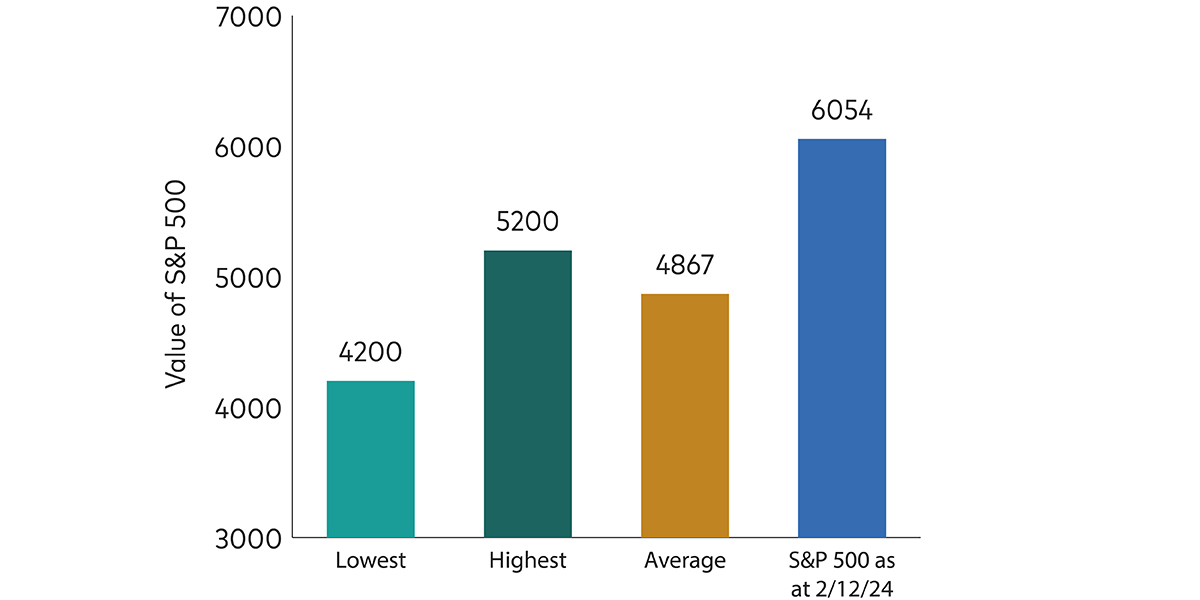
Four lessons to take into 2025
Vanguard’s James Norton reflects on the investment landscape over 2024 and highlights four lessons he will take into the new year.
Throughout 2024, we’ve witnessed events such as two elections in the US and UK and ongoing conflicts. Occurrences like these often create turbulence and can sometimes trigger knee-jerk reactions when it comes to investing. Despite this, the stock market has exceeded the expectations of experts around the world1.
Economies have recovered following the knock-on effects of the pandemic, with inflation coming down and US shares being the standout performer with returns of 28%2. UK shares also rose with returns of 11%3.
After a tough 2022 and 2023, this year has also been much more positive for bonds4, with global bonds up 3.5%5. That’s because bond prices tend to rise when interest rates are falling, so the expectation of interest-rate cuts was good news for bond investors.
You can’t time the market
Why does any of this matter? The strong performance of stock markets this year came despite significant uncertainty and is a reminder that markets will always have the ability to surprise us – whether the result is positive or negative for your investments – and so trying to time them is futile.
The chart below shows analysts’ forecasts, provided by Bloomberg, made at the end of 2023, for the performance of the S&P 500 (which tracks the 500 largest US companies) in 2024. The average analyst forecast (the gold bar) was almost 20% lower than the S&P 500’s current level. Even the highest forecast (the dark green bar) underestimated the S&P 500’s performance by about 14%. With a couple of weeks of the year still to go, anything could happen, but the S&P 500 is currently at an all-time high of 6,054 (the blue bar), well above all of these forecasts. This underscores how frequently short-term forecasts can be wrong.
S&P 500: 2024 Year-end predictions vs current level

Source: Bloomberg. Data as at 2 December 2024.
Avoid the bandwagon
Why have markets done so well when so many people expected otherwise? The main reasons for the US stock market’s stellar performance over the past decade have been strong growth in company profits and a large proportion of those companies being in the technology sector. The rally has been more widespread, beyond technology and across other industries, since the US election.
Technology makes up 32% of the S&P 500 Index6, compared to just 13% of the MSCI ACWI ex USA Index, an index of global companies excluding the US.
However, we have been cautioning investors for some time that US shares are expensive, or ‘overvalued’. This is partly due to developments in artificial intelligence (AI) technology, which have created excitement and helped propel US valuations7 to levels not seen since the dot-com bubble – and its subsequent burst – in the late 1990s and early 2000s8.
We think it could take many years to realise the full potential of AI. While substantial benefits appear likely, a meaningful risk of disappointment remains and so investors should try to ignore the “hype” and avoid jumping on the bandwagon.
Many believe AI will make companies more productive and efficient and lead to new innovations. While they may well be proved right in the long run, parallels between the dot-com bubble and today's excitement around AI offer a cautionary tale about the importance of spreading your money across different types of investments, industries and geographical regions.
Think long-term and be diversified
Regardless of the economic and market outlook, having a balanced portfolio can help to smooth out returns over time. This is because the better-performing investments help to offset those that perform less well.
A balanced portfolio is one that invests in both shares and bonds to reduce the impact of swings in prices in one particular asset type. For example, a typical balanced portfolio might have 60% in shares and 40% in bonds. Periodically, pundits declare the death of the 60/40 portfolio, but we think it’s alive and kicking.
The graph below shows a simple example of the relationship between shares and bonds to demonstrate the impact on portfolio returns.
The first bar (light green) shows a portfolio with 100% bonds and no shares. This portfolio has an average return of 5%, but its returns range from 53.1% to -23.2%. Each subsequent bar shows a 10-percentage-point increase in the proportion of shares and a corresponding 10-percentage-point decrease in the proportion of bonds. As the proportion of shares increases, the average return also rises, but the range of returns becomes wider.
For example, the final bar (peach), which shows a portfolio with 100% shares and no bonds, has an average return of 8.7% and a much wider range of returns from 145% to -52.6%. This shows that while shares have delivered higher returns than bonds over the long term, they can also result in greater losses. Therefore it pays to find the right balance appropriate to your goals and attitude to risk.
A portfolio’s mix of assets defines its range of returns

Past performance is not a reliable indicator of future results.
Source: Vanguard
Notes: Reflects the maximum and minimum calendar year returns, along with the average annualised9 return, from 1901-2023, for various share and bond allocations, rebalanced10 annually. Shares are represented by the DMS UK Equity Total Return Index from 1901 to 1969; thereafter, shares are represented by the MSCI UK Total Return Index. Bond returns are represented by the DMS UK Bond Total Return Index from 1901 to 1985; the FTSE UK Government Index from Jan 1986 to Dec 2000 and the Bloomberg Sterling Aggregate Index thereafter. Returns are in sterling, with income reinvested, to 31 December 2023.
Spreading your investments across different assets, sectors and countries can help to stabilise the overall performance of your portfolio, while also cushioning against unnecessarily large losses from any one investment.
This is because shares and bonds have historically behaved differently to each other, with shares tending to perform better than bonds in the long run but also tending to be more volatile (fluctuating in price). Bonds have tended to act as a counterweight to shares, helping to smooth out returns.
Catchy phrases like the “death of 60/40” are easy to remember. But such statements ignore the basic facts of investing, focus on short-term performance and create a dangerous disincentive for investors to remain disciplined about their long-term goals.
Stay the course
When portfolios are falling in value, it’s in our nature to want to fix things. But a truism of investing is that your portfolio will not go up in a straight line. Markets can go up and down and taking action may help us feel better – as if we’re doing something productive. But more often than not, staying the course and sticking to your plan is the right thing to do.
Even though 2024 has certainly been an eventful year, I plan to do more of the same. That is, leaving my portfolio as it is based on my goals and attitude to risk, and occasionally rebalancing it to maintain the proportion of shares and bonds that I’m comfortable with.
At this time of year, it’s important to take a step back and focus on your goals. While the future, as always, is uncertain, holding a balanced portfolio and staying disciplined will give you the best chance of investment success.
1 Analyst forecasts - see chart: S&P 500: 2024 Year-end predictions vs current level. Bloomberg. Data as at 2 December 2024.
2 Returns measured by the S&P 500 from 31 December 2023 to 30 November 2024. Vanguard calculations in GBP, based on data from Bloomberg.
3 Returns measured by the MSCI UK Index from 31 December 2023 to 30 November 2024. Vanguard calculations in GBP, based on data from Factset.
4 Bonds are a type of loan issued by governments or companies, which typically pay a fixed amount of interest and return the capital at the end of the term.
5 Returns measured by the Bloomberg Global Aggregate Bond Sterling Hedged Index from 31 December 2023 to 30 November 2024. Vanguard calculations in GBP, based on data from Bloomberg.
6 An index typically measures the performance of a basket of investments, such as shares or bonds, that are intended to represent a certain area of the market.
7 A measure of how well company share prices are justified by important measures such as their profits.
8 Source: Vanguard calculations based on data from Robert Shiller’s website, the US Bureau of Labor Statistics, the Federal Reserve Board, Refinitiv and Global Financial Data. As at 1 January 2024.
9 Annualised returns show what an investor would earn over a period of time if the annual return was compounded (i.e. the investor earns a return on their return as well as the original capital).
10 Rebalancing means changing the mix of investments in your portfolio if they move out of line with the target mix for your risk profile.
Investment risk information
The value of investments, and the income from them, may fall or rise and investors may get back less than they invested.
Past performance is no guarantee of future returns. The performance of an index is not an exact representation of any particular investment, as you cannot invest directly in an index.
Important information
Vanguard only gives information on products and services and does not give investment advice based on individual circumstances. If you have any questions related to your investment decision or the suitability or appropriateness for you of the product[s] described, please contact your financial adviser.
This is designed for use by, and is directed only at persons resident in the UK.
The information contained herein is not to be regarded as an offer to buy or sell or the solicitation of any offer to buy or sell securities in any jurisdiction where such an offer or solicitation is against the law, or to anyone to whom it is unlawful to make such an offer or solicitation, or if the person making the offer or solicitation is not qualified to do so. The information does not constitute legal, tax, or investment advice. You must not, therefore, rely on it when making any investment decisions.
The information contained herein is for educational purposes only and is not a recommendation or solicitation to buy or sell investments.
Issued by Vanguard Asset Management Limited, which is authorised and regulated in the UK by the Financial Conduct Authority.
© 2024 Vanguard Asset Management Limited. All rights reserved.

